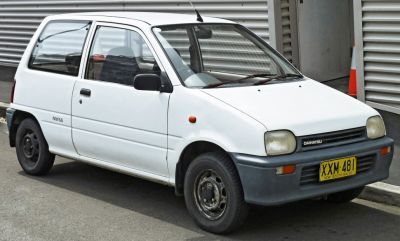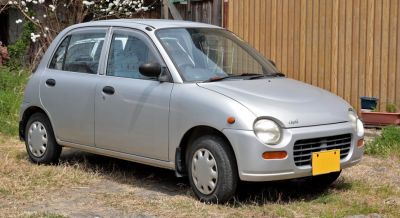 1990 Mazda Carol Dimensions, Size & Specs
1990 Mazda Carol Dimensions, Size & Specs
Measurements of the 1990 Mazda Carol, engineered for optimal performance and comfort
| Dimensions | |
|---|---|
| Length: | 3290 mm129.5 in10.8 ft |
| Width: | 1395 mm54.9 in4.6 ft |
| Height: | 1400-1425 mm55.1-56.1 in4.6-4.7 ft |
| Weight Specifications | |
| Curb Weight: | 660-690 kg1455-1521 lbs |
| Tire Specifications | |
| Rims Sizes: | Other Rims:
|
| Tire Sizes: |
|
The 1990 Mazda Carol represents a classic example of Japanese compact hatchback design, produced between 1989 and 1998. This generation of the Carol is particularly noted for its modest and practical dimensions, making it an ideal choice for urban driving and tight spaces. The vehicle measures 3290 mm (129.5 inches) in length, with a narrow width of 1395 mm (54.9 inches), which helps in maneuverability through crowded streets. The height varies between 1400 mm to 1425 mm (55.1 to 56.1 inches), providing a compact yet comfortable cabin space.
With a curb weight ranging from 660 to 690 kg (approx. 1455 to 1521 lbs), the Mazda Carol emphasizes lightness and efficiency. It comes equipped with small rims sized 4J x 12 ET 45 and 4J x 13 ET 45, paired with tires in sizes 155/70 R12 75S and 155/65 R13 75S respectively, ensuring a balanced ride and handling suited to city environments.
The hatchback's compact footprint and lightweight design make it highly economical in fuel consumption and easy to park, typical of kei cars prevalent in Japan at the time. It's an excellent option for drivers who need reliable transportation without the bulk of larger vehicles. The Mazda Carol's size and properties place it comfortably within the category of small hatchbacks, providing a useful benchmark for car size comparison, especially in evaluating urban small cars and kei-class vehicles.
Discover the standout features that make the 1990 Mazda Carol a leader in its class
Have a question? Please check our knowledgebase first.
The 1990 Mazda Carol hatchback measures 3290 mm (129.5 inches) in length, 1395 mm (54.9 inches) in width, and its height varies between 1400 mm to 1425 mm (55.1 to 56.1 inches). These compact dimensions make it a small urban car, ideal for navigating tight city streets and parking in confined spaces. Despite its small size, the design maximizes interior space effectively, typical of kei cars of this period.
The curb weight of the 1990 Mazda Carol ranges between 660 kg to 690 kg (1455 to 1521 pounds). This lightweight design helps improve fuel efficiency and agility. Compared to other kei cars from the late 1980s and 1990s, this weight is typical and contributes to the vehicle's nimble handling characteristics. The relatively low weight also supports the small engine size common in kei cars, helping to maintain good fuel economy.
The 1990 Mazda Carol typically comes with rim sizes of 4J x 12 ET 45 and 4J x 13 ET 45, fitted with tires sized 155/70 R12 75 S and 155/65 R13 75 S. These tire sizes and rim dimensions are consistent with the vehicle's compact size and ensure a smooth, comfortable ride while maintaining stability and handling suited for urban driving environments.
Yes, the 1990 Mazda Carol easily fits into a standard residential garage. With a length of 3290 mm (129.5 inches) and width of 1395 mm (54.9 inches), it is significantly smaller than average cars, making it very manageable for typical garage spaces which often accommodate vehicles around 4.5 to 5 meters in length and 2 meters in width. Its compact footprint is ideal for parking in tight spots commonly found in residential areas.
The height of the 1990 Mazda Carol varies between 1400 mm and 1425 mm (55.1 to 56.1 inches), depending on the specific model and configuration. This slight variation in height affects headroom inside the cabin, with taller versions offering a bit more space for passengers, improving comfort particularly for taller individuals. The overall compact profile still maintains the car’s agility while attempting to optimize usable interior volume in its classification as a kei car.
Compared to its predecessor, the 1990 generation Mazda Carol maintained the hallmark compactness expected in the kei car segment but saw slight dimensional refinements. Typically, this generation improved slightly in length and interior packaging without significantly increasing the footprint. These changes resulted in a more modern appearance and marginally improved cabin space and comfort while maintaining maneuverability and small size for urban environments.
The 1990 Mazda Carol's dimensions are very much in line with other kei cars from the late 1980s and early 1990s. Its length of 3290 mm (129.5 inches), width of 1395 mm (54.9 inches), and weight around 660 to 690 kg (1455 to 1521 pounds) put it squarely within the typical size and weight limits defined by kei car regulations in Japan. Competitors like the Suzuki Alto or Honda Today of the era shared similar dimensions, making the Carol competitive in tight urban environments.
The compact dimensions of the 1990 Mazda Carol – notably its short length (3290 mm/129.5 inches) and narrow width (1395 mm/54.9 inches) – contribute significantly to its nimble handling and easy maneuverability. Its relatively low weight (660-690 kg) further enhances responsiveness and makes city driving effortless. The small size also aids in parking in tight spaces, a key benefit in densely populated urban areas where space is limited.
The 1990 Mazda Carol, despite its small exterior dimensions, efficiently uses interior space to comfortably seat four passengers, standard for kei cars. While compact, the cabin design prioritizes passenger comfort with adequate headroom helped by the 1400-1425 mm (55.1-56.1 inches) height range. Storage space is limited but sufficient for city errands and daily commuting, aligning with the vehicle’s urban mobility focus.
The factory rim sizes (4J x 12 ET 45 and 4J x 13 ET 45) equipped with 155/70 R12 75 S and 155/65 R13 75 S tires provide a balance between ride comfort and handling. The smaller 12-inch tires offer a smoother ride suitable for city roads, while 13-inch tires can enhance cornering stability and response. Both setups maintain low rolling resistance, supporting fuel efficiency and contributing to the vehicle's easy maneuverability in urban environments.
Discover similar sized cars.

| Production: | 1990-1994 |
|---|---|
| Model Year: | 1990 |
| Length: | 3295 mm129.7 in |
| Width: | 1395 mm54.9 in |
| Height: | 1410 mm55.5 in |

| Production: | 1992-1998 |
|---|---|
| Model Year: | 1992 |
| Length: | 3295 mm129.7 in |
| Width: | 1395 mm54.9 in |
| Height: | 1395 mm54.9 in |

| Production: | 1997-2008 |
|---|---|
| Model Year: | 1997 |
| Length: | 3200-3350 mm126.0-131.9 in |
| Width: | 1420 mm55.9 in |
| Height: | 1400-1415 mm55.1-55.7 in |

| Production: | 1992-1998 |
|---|---|
| Model Year: | 1992 |
| Length: | 3295 mm129.7 in |
| Width: | 1395 mm54.9 in |
| Height: | 1375-1385 mm54.1-54.5 in |
